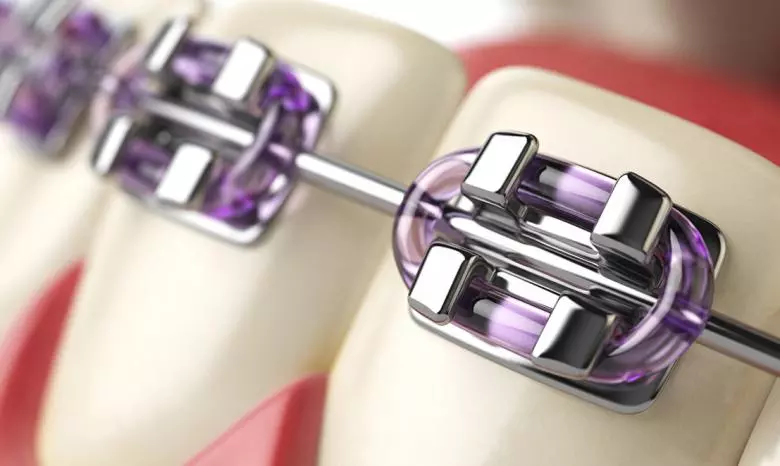Whatsapp: +90 (554) 160 5747 Online Appointment

Orthodontics is the branch of dentistry responsible for diagnosing, preventing, and correcting irregularities of the teeth, jaws, and facial structures.
The methods of applying orthodontic treatment are as follows:
Placement of Brackets: There are fundamentally two types of brackets: metal and ceramic (transparent). The most commonly used method involves placing brackets, wires, and elastics. Brackets are bonded to the teeth, and wires are passed through the brackets to apply pressure to the teeth. In this way, the teeth are gradually moved into proper alignment. Treatment can last from a few months to a few years, with monthly adjustments ensuring the desired level of improvement. Recently, lighter brackets containing less metal have been developed. They come in various colors to motivate children and in transparent forms for adults.
Special Fixed Appliances: These appliances, which are banded to the teeth, are used to break habits like thumb sucking. They are not very comfortable during eating, so they are recommended only as a last resort.
Fixed Space Maintainers: If baby teeth are lost prematurely, a space maintainer is used to prevent neighboring teeth from shifting into the open space until the permanent tooth erupts.
Aligners (Bracket-Free Treatment): As an alternative to fixed treatment with brackets for adults, many orthodontists choose aligners because they align the teeth without the use of brackets or wires. Aligners are usually transparent and can be removed when eating, brushing, or flossing.
Removable Space Maintainers: These serve the same purpose as fixed space maintainers. They consist of an acrylic base that sits on the jaw and use plastic or wires to fill the space between certain teeth.
Appliances Developed to Reposition the Jaw: Called splints, these devices are placed on either the lower or upper jaw to help it close in a more favorable position. They can also be used to correct temporomandibular joint (TMJ) disorders.
Lip and Cheek Bumper: An appliance that pushes the teeth backward and prevents the lips and cheeks from putting pressure on the teeth. Lip and cheek muscles can exert force on the teeth; bumpers help prevent this.
Jaw Expander: A device used to widen the upper jaw. It is made of a plastic material that sits on the palate. By tightening screws, a force is applied that causes the bone under the palate to move apart.
Removable Retainers: These are passive appliances used after treatment to maintain the new position of the teeth and prevent them from returning to their former state. If necessary, they can be adjusted to help stop habits like thumb sucking.
Headgear: A device consisting of a strap around the back of the head and a metal wire attaching to the front of the head. Headgear slows the growth of the upper jaw and holds the back teeth in place while moving the front teeth backward.
IS THERE AN AGE LIMIT FOR ORTHODONTIC TREATMENT?
There is no age limitation for correcting orthodontic issues that involve only the teeth. Orthodontic treatment can be applied from the age of 7 up to 70, provided that the teeth and gums are healthy. However, it is thought that the treatment duration may increase as the patient gets older.
If there is a skeletal (bone-related) issue, age matters; orthodontic treatment should be applied before adolescence. After the jaw development is complete, it is not possible to intervene in bone growth. Therefore, orthodontic problems involving the jawbones can only be corrected with surgery in later years.
Duration of Orthodontic Treatment:
The duration of orthodontic treatment varies greatly depending on the condition in the patient’s mouth and the technique used. Factors such as the patient’s age, whether growth and development are continuing, and the number of treatment stages all affect the length of treatment. Routine fixed orthodontic treatments generally last between 6 months and 2 years.
WHAT ARE THE BENEFITS OF ORTHODONTIC TREATMENT?
Teeth that are crowded are more difficult to clean, increasing the risk of gum disease and decay. After orthodontic treatment, teeth become easier to clean. If there is not an ideal bite relationship between the upper and lower jaws, chewing, swallowing, and speech functions may not be performed optimally.
After orthodontic treatment, if there are no other factors interfering with these functions, chewing can be improved, and the pronunciation of letters can become more accurate. A fuller and more aesthetic smile following treatment also helps increase a person’s confidence in social life.
When there is a problem with the bite alignment between the jaws, issues such as pain or noises in the lower jaw joint can occur. Correcting the bite through orthodontic treatment can reduce the likelihood of these problems. However, it should be noted that an incorrect bite is not always the sole cause of joint disorders.
Things to Consider During Orthodontic Treatment:
During orthodontic treatment, you can usually continue most of your daily activities as before. However, certain foods—like gum, fizzy drinks, and hard foods—can damage the orthodontic appliances, so dietary restrictions may apply. Also, because orthodontic treatment is a lengthy process, it is crucial not to miss scheduled appointments.
Endodontics is the branch of dentistry that deals with the treatment of root…
A healthy and beautiful smile gives you an advantage in many areas of life. It…
Teeth lose their whiteness over time due to the consumption of certain foods,…